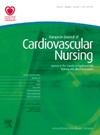COVID 时代前后:大流行对心血管检查次数有何影响?
IF 3.9
3区 医学
Q2 CARDIAC & CARDIOVASCULAR SYSTEMS
引用次数: 0
摘要
引言 大量证据表明 COVID-19 与心血管疾病之间存在密切联系。最近的数据表明,COVID-19 可能会增加未来罹患心血管疾病的风险,其程度与传统的心血管风险因素类似。卫生从业人员、护士和医生有一个假设,即自从 COVID 开始使用以来,越来越多的年轻患者寻求心血管检查。本研究的目的是按性别和年龄比较 COVID 流行前后心血管检查的次数。材料和方法 我们调查了马其顿共和国斯科普里市赞-米特列夫诊所诊断中心在 COVID-19 前三年(即 2017 年 1 月至 2020 年 3 月)和大流行开始后三年(即 2020 年 3 月至 2023 年 3 月)期间进行的心血管检查总数。我们按 COVID 前后患者的性别和年龄进行了比较。我们医院的心血管检查包括心电图、超声心动图和心脏科会诊。所有收集的数据均来自医院信息系统。结果 2017年1月至2020年3月期间,共进行了24496次心血管检查。患者队列中包括 13374 名男性(55%)和 11121 名女性(45%)。平均年龄为 53±30 岁。2020 年 3 月至 2023 年 3 月期间,共进行了 33,825 次心血管检查,患者包括 18,137 名男性(54%)和 15,687 名女性(46%)。平均年龄为 55±43 岁。结论 尽管在 COVID 大流行开始后,心血管检查的次数似乎呈上升趋势,但在 COVID 时代前后,按年龄和性别分类的数据在统计学上并无显著差异。本文章由计算机程序翻译,如有差异,请以英文原文为准。
Pre - and post- COVID era: how did the pandemic impact the number of cardiovascular examinations?
Introduction A lot of evidence suggests a close link between COVID-19 and cardiovascular diseases. Recent data indicate that COVID-19 may increase the risk of cardiovascular diseases in the future, to an extent similarly observed in reference to the more traditional cardiovascular risk factors. Health practitioners, nurses, and doctors have a hypothesis that, since COVID began, more and more younger patients seek cardiovascular examinations. The Purpose of this study is to compare the number of cardiovascular examinations before and after the beginning of the COVID pandemic, by gender and age. Materials and Methods We examined the total number of cardiovascular examinations performed at the diagnostic center, Zan Mitrev clinic, Skopje, R. Macedonia, for a period of three years before COVID-19, i.e., from January 2017 to March 2020, and three years after the start of the pandemic, i.e. from March 2020 to March 2023. We structured the comparison by gender and age of the patients before and after COVID. Cardiovascular examination in our hospital comprises electrocardiography, echocardiography and cardiologic consultation. All of the collected data came from the Hospital Information System. Results A total of 24,496 cardiovascular examinations were performed between January 2017 and March 2020. The cohort of patients comprised 13,374 men (55%) and 11,121 (45%) women. The average age was 53±30 years. During the period from March 2020 to March 2023 a total of 33,825 cardiovascular examinations were performed, and the patients comprised 18,137 (54%) men and 15,687 (46%) women. The average age was 55±43 years. Conclusions Although there seems to be an upward trend of the number of cardiovascular examinations after the COVID pandemic started, there is no statistically significant difference between the data categorized by age and gender before and after the COVID era.
求助全文
通过发布文献求助,成功后即可免费获取论文全文。
去求助
来源期刊

European Journal of Cardiovascular Nursing
CARDIAC & CARDIOVASCULAR SYSTEMS-NURSING
CiteScore
5.10
自引率
10.30%
发文量
247
审稿时长
6-12 weeks
期刊介绍:
The peer-reviewed journal of the European Society of Cardiology’s Council on Cardiovascular Nursing and Allied Professions (CCNAP) covering the broad field of cardiovascular nursing including chronic and acute care, cardiac rehabilitation, primary and secondary prevention, heart failure, acute coronary syndromes, interventional cardiology, cardiac care, and vascular nursing.
 求助内容:
求助内容: 应助结果提醒方式:
应助结果提醒方式:


